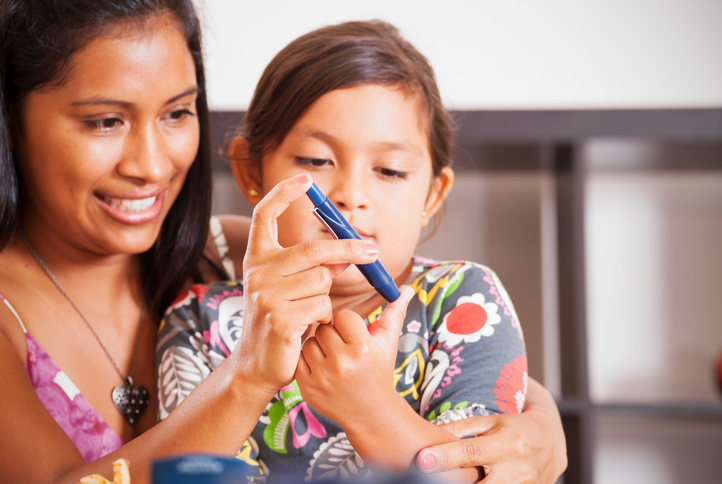
Type 2 diabetes, formerly called adult onset diabetes, does not just occur in adults. Did you know it can also occur in children and adolescents? Our understanding of diabetes in youth has changed over the last two decades. It used to be a rare situation to see any child or adolescent diagnosed with type 2 diabetes. These days with the rise in childhood obesity, the strong genetic nature of this type of diabetes and improvements in health screening, we are finding more and more children and teens with type 2 diabetes.
The two most common types of diabetes are type 1 and type 2. Just so we are all clear on the similarities and differences between them – let’s review:
Both type 1 diabetes (T1D) and type 2 diabetes (T2D) are chronic conditions that affect how the body regulates blood sugar (glucose). Glucose is the fuel that comes from the food we eat and from stored sources in the body. Glucose provides the body energy at the most basic level – in the body’s cells. Kind of like gasoline for a car, glucose gives energy to the body to keep it going. Insulin is a hormone (made in the pancreas) that acts like a key to open up the cell to let glucose into the cell do its job.
Type 1 Diabetes
Type 1 diabetes happens when the pancreas does not make enough insulin. The body’s own immune system that usually works to fight off invaders like infections gets misdirected to attack the body’s own healthy cells (auto-immune disease). In the case of type 1 diabetes, the attack focuses on the beta cells in the pancreas destroying that organ’s ability to make insulin (the keys). When you don’t have the keys to let sugar into the cells to be used for energy, the body cannot work well and glucose stays in the blood, causing high blood sugar. This is the reason every person with T1D needs to take insulin without exception.
Type 2 Diabetes
Type 2 diabetes starts when people still make insulin, but the body does not respond normally to it (insulin resistance). Often in the beginning, the body makes even more insulin than usual in an attempt to have more “keys” to open the doors to the cells for the rising glucose. The keys are available in T2D, but just not able to open the cell’s door to let the sugar in to be used for energy. So just like T1D, the glucose cannot enter the cell to do its work, so it accumulates in the blood causing high blood sugar. Over time the body starts making less and less insulin.
Stats & Risk Factors
Usually when we think about diabetes in youth, we are thinking about type 1 diabetes. In fact we used to call type 1 diabetes “juvenile onset”. Now we have a better understanding that type 1 diabetes and type 2 diabetes can occur at any age. From recent studies comparing the annual estimate of newly diagnosed children and adolescents with diabetes, about 25% of all new cases (ages 10-20 years) were T2D. In the U.S., type 2 diabetes is more common in the Native American, Hispanic, Asian, Pacific Islander and African American populations.
In children and teens who develop type 2 diabetes, about 75% of those kids have a close relative with diabetes. Even though genetics and family history is a strong influence, in most cases the diagnosis seems to be influenced by some important factors. Although we do not have as much research on T2D in youth as compared to adults, it seems that prevention (especially in high risk groups) needs to start in early childhood and focus on the following:
- Maintaining regular physical activity
- Eating in a healthy way
- Keeping weight in a healthy range
- Having access to adequate health care to screen for diabetes and other health issues related to obesity such as liver problems, menstrual irregularity and blood pressure/cardiovascular issues
Signs & Symptoms
Signs of T2D to look for in an overweight youth might include:
- Darkening of the skin on the neck, knees, underarms and skin folds (this skin finding is associate with insulin resistance)
- Thirst – Drinking more than usual
- Having to urinate frequently – Day and Night – Wetting the bed
- Blurry Vision
- Family history of type 2 diabetes
Many of the above symptoms are totally absent, which makes screening individuals with risk factors so important. Screening basically involves measuring the blood glucose level and getting an HgbA1c measurement. Treatment of T2D includes a healthy diet, regular physical activity, blood glucose testing and medications that may or may not include insulin. The most common oral medication that young people with T2D take is metformin. Metformin is a pill that allows the body’s own insulin work better and reduces release of stored glucose made in the liver. These mechanisms help keep the blood sugar in a healthier place, and there are a lot of other oral and injectable medications currently being studied in younger individuals with T2D.
We are learning more and more about type 2 diabetes in youth with each passing year. If the signs and symptoms sound familiar, be sure to see a pediatrician to screen for diabetes and intervene appropriately.


Leave a Reply